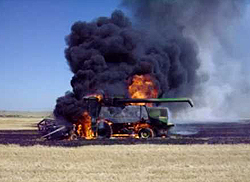 Looking at published data, professional research and local newspaper reports from the past two years this article highlights the most common causes of combine harvester fires.
Looking at published data, professional research and local newspaper reports from the past two years this article highlights the most common causes of combine harvester fires.
Perhaps the main contributing seasonal factor to combine fires is the weather. A long, hot, dry harvest spells increased risk of fire. Straw more easily catches fire and standing crops can turn a small fire into a large blaze very quickly.
The main contributing human factor may well be tiredness. Combine fires are more common towards the tail end of the harvest. After hundreds of hours spent in the field, both man and machine are tired and in a less fit state than when the season began. The potentially fatal combination of human fatigue and poor machine maintenance routines greatly increases the risk of fire.
To minimise fire risk, it is vital to keep the combine as free as possible from dust, chaff and other debris. A build-up of combustible material adjacent to an overheating engine, exhaust manifold, turbocharger or other moving parts is probably the number one cause of combine fires, and one that can easily be prevented through the strict implementation of regular cleaning and maintenance schedules. Good maintenance also helps minimise the likelihood of mechanical or electrical failure, two very significant causes of combine fires.
As well as at least two fire extinguishers on board, combine drivers should have a powerful enough air compressor and lance to blow off any build up of straw, dust and chaff. In hot, humid conditions cleaning routines should be stepped up dramatically and extinguishers checked at regular intervals.
Other than the heat of the engine, exhaust, bearings and brake components, another source of ignition can be the metal combine header striking flint and producing sparks. Although these types of causes are almost impossible to verify for certain, great care should nevertheless be taken to set the header at a sufficient height to avoid such strikes, especially when turning and performing other manoeuvres.
Whilst the vast majority of combine harvester fires start in the field whilst combining, others happen on roads between jobs and in barns where they are stored so care must be taken at all times.
If possible, never store a combine harvester next to, near or in the same barn as bales of hay or other dry combustible material. Fires in barns are not unusual and can quickly spread to adjacent farm machinery. Even something as simple and commonplace as a neighbour setting off fireworks becomes a huge fire risk when valuable machinery is stored next to hay bales.
Recognizing that fire is an inherent risk of combining, farmers and contractors must always make certain that their insurance cover is adequate and includes fire damage to crops as well as machinery.